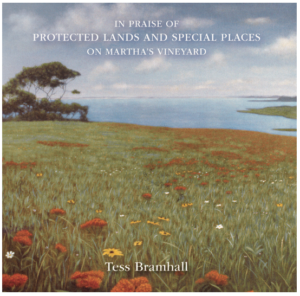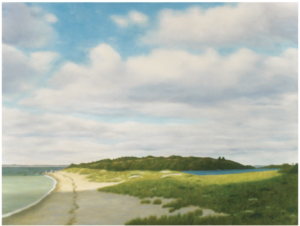In Praise of Protected Lands and Special Places on Martha’s Vineyard
Book excerpt
by Tess Bramhall

“People speak for themselves but the land cannot talk, so we who love Martha’s Vineyard must speak for it, must advocate for its survival as we know and love it,” writes Tess Bramhall in her new book In Praise of Protected Lands and Special Places on Martha’s Vineyard.
Bramhall, whose husband Kib and daughter Emily have both served on the Sheriff’s Meadow Foundation board, writes about twenty-one properties across the Island that are in conservation and are open to the public. Her engaging stories enlighten us with information about the history and geology of the land. Bramhall is, in a way, our docent, taking us on a museum-quality conservationist’s walking tour of the Vineyard. Each property she writes about is represented with artwork by some of the Island’s best known artists, including paintings by her husband Kib Bramhall, Andrew Moore, Ruth Kirchmeier, Allen Whiting, Stan Murphy, and Rez Williams.
Bramhall writes about three SMF properties in her book and has generously given the SMF newsletter permission to excerpt the section about Cedar Tree Neck.
Cedar Tree Neck

Cedar Tree Neck, Painting by Kib Bramhall 2008
The land at Cedar Tree Neck, now owned by SMF, was thought to have been inhabited by Wampanoag people until the 1770s when Mayhew Norton bought it from them and built his family a house there. Norton was a ship’s pilot and it was thought that he chose Cedar Tree Neck because it projects further into Vineyard Sound then any other point of land on the Vineyard’s North Shore.
In those days there were no buoys or lighthouses to help ships navigate Vineyard Sound’s waters, which had numerous dangerous glacial rocks under its surface. The Gay Head Light House was not built until 1799; so experienced pilots were needed by ship captains who were unfamiliar with the many rocky areas in the Sound.
After piloting a vessel to Boston, Norton would walk to New Bedford, some 50 miles away and wait for a small sailing boat that was heading to the Vineyard. No matter what Island port it landed in, Mayhew Norton would walk back home to the far reaches of the north shore, down the dirt tracts that abounded in those days.
The second family to live in the Norton house, and they did so until the 1960s, was the Daggett family. This family farmed the soil, and they had as summer neighbors in the late 19th century and into the 20th century the family of Henry Beetle Hough, later the founder of the SMF.
When Henry was a child in the early 1900s, there was nothing he liked to do better than explore the nearby land with his older brother, George. They roamed the hilly, open and wooded lands of Cedar Tree Neck, Seven Gates Farm, and of their own family property which their father had named “Fish Hook” because it was “at the end of the line.”
I had the great pleasure of knowing Henry and when my husband Kib and I bought land in 1977, adjacent to Fish Hook. Henry came to see our land and said excitedly: “It is the Commanding View!” He remembered when he had discovered it as a boy, coming often to sit on a rock to look out at the
Elizabeth Islands.
Another Henry story; he was determined to find an old cellar hole he remembered as a child between his house and ours. We set off on the path he had in mind, and after not immediately finding it, he asked us to wait while he headed directly into the woods to search it out. I have never witnessed a human being moving like a bird flying through tree branches, but that is what Henry could do, showing that his total adaptation to his childhood surroundings remained with him even in his eighties. It is a vivid memory for me. We never found the cellar hole, however.
In 1920 Henry Hough became the owner of the Vineyard Gazette, the island’s oldest newspaper founded 1846. It was a wedding present to he and his wife, Betty, from his father, himself a newspaperman. Henry was also the paper’s editor, a position he held until his death in 1985. He never forgot his childhood summer land, it remained deeply etched in his heart. Here is a beautiful description of Cedar Tree Neck written by Henry Hough later in his life:
This promontory – undecided as between boldness and mildness, and achieving a magical, changing blend of the two – gave the Vineyard a point for its triangular shape and its farthest extension into Vineyard Sound. From the high point of the Neck you could look both ways. The Neck was almost islanded itself by a large pond just to the west and a smaller pond and marsh in front and the deep bend of the sound on both sides.
The sky over Cedar Tree Neck seemed always purposefully vast, whether on a sunny day or in dark winter chill, invariably and stimulatingly fresh for breathing.
The elements mixed themselves in bracing proportion. Gales from the northeast or northwest brought rollers crashing in with slantwise shifting, but the true nature of the sound at this place of division seemed to be the blue glimmering serenity to which it always returned.
It is indeed a magical place, and when it became the Cedar Tree Neck Sanctuary, in the mid-1960s, its 312 acres were comprised of the Obed Sherman and Maria Roberts Daggett Sanctuary and land gifted by the Hough family to the newly formed SMF. The money raised to purchase it also came through public donations, an early example of involving the public in protecting land.
Copies of In Praise of Protected Lands and Special Places on Martha’s Vineyard can be purchased at www.endowmv.com, at Bunch of Grapes and Edgartown Books. All proceeds from book sales benefit the Land Protection Fund.
SMF would like to thank Tess and Kib Bramhall for permission to reprint this excerpt and painting.





